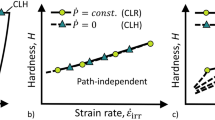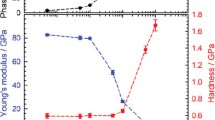Abstract
New experimental methods have been developed to optimize the accuracy and precision of the measured phase angle in nanoindentation experiments on viscoelastic materials performed with a Berkovich indenter. Measurements conducted in fused silica and sapphire form the basis of a new instrument calibration. Experimental verification of the new calibration and an enhanced test method is demonstrated in polycarbonate (PC) and polymethyl methacrylate (PMMA). In comparison to the standard continuous stiffness measurement (CSM) technique, the new calibration and test method reduces the measurement error in the phase angle of PC from 1900% to 10% and from 135% to 10% in PMMA. Scatter in phase angle measured by the new test method is nearly 10 times less than the level observed using the standard CSM technique. The effect of time dependent deformation on the measured phase angle is also documented. The experimental observations and results are applicable to a variety of dynamic nanoindentation test methods.














Similar content being viewed by others
References
W.C. Oliver and G.M. Pharr: Measurement of hardness and elastic modulus by instrumented indentation: Advances in understanding and refinements to methodology. J. Mater. Res. 19(1), 3 (2004).
C.C. White, M.R. Vanlandingham, P.L. Drzal, N-K. Chang, and S-H. Chang: Viscoelastic characterization of polymers using instrumented indentation. II. Dynamic testing. J. Polym. Sci., Part B: Polym. Phys. 43(14), 1812 (2005).
S. Pathak, J.G. Swadener, S.R. Kalidindi, H.W. Courtland, K.J. Jepsen, and H.M. Goldman: Measuring the dynamic mechanical response of hydrated mouse bone by nanoindentation. J. Mech. Behav. Biomed. Mater. 4(1), 34 (2011).
G. Huang, N.P. Daphalapurkar, R.Z. Gan, and H. Lu: A method for measuring linearly viscoelastic properties of human tympanic membrane using nanoindentation. J. Biomech. Eng. 130(1), 014501 (2008).
A.K. Bembey, M.L. Oyen, A.J. Bushby, and A. Boyde: Viscoelastic properties of bone as a function of hydration state determined by nanoindentation. Philos. Mag. 86(33–35), 5691 (2006).
N. Rodriguez, M.L. Oyen, and S.J. Shefelbine: Insight into differences in nanoindentation properties of bone. J. Mech. Behav. Biomed. Mater. 18, 90–99 (2013).
D.G. Kim, D. Gyoon, S.S. Huja, A. Navalgund, A. D’Atri, B.C. Tee, S. Reeder, and H.R. Lee: Effect of estrogen deficiency on regional variation of a viscoelastic tissue property of bone. J. Biomech. 46(1), 110–115 (2013).
D.G. Kim, S.S. Huja, R.L. Hye, B.C. Tee, and S. Hueni: Relationships of viscosity with contact hardness and modulus of bone matrix measured by nanoindentation. J. Biomech. Eng. 132, 2 (2010).
H. Isaksson, M. Malkiewicz, R. Nowak, H.J. Helminen, and J.S. Jurvelin: Rabbit cortical bone tissue increases its elastic stiffness but becomes less viscoelastic with age. Bone 47(6), 1030 (2010).
H. Isaksson, S. Nagao, M. MaŁkiewicz, P. Julkunen, R. Nowak, and J.S. Jurvelin: Precision of nanoindentation protocols for measurement of viscoelasticity in cortical and trabecular bone. J. Biomech. 43(12), 2410 (2010).
M. Sakai: Time-dependent viscoelastic relation between load and penetration for an axisymmetric indenter. Philos. Mag. A 82(10), 1841 (2002).
L. Cheng, X. Xia, W. Yu, L.E. Scriven, and W.W. Gerberich: Flat-punch indentation of viscoelastic material. J. Polym. Sci., Part B: Polym. Phys. 38(1), 10 (2000).
E.G. Herbert, W.C. Oliver, A. Lumsdaine, and G.M. Pharr: Measuring the constitutive behavior of viscoelastic solids in the time and frequency domain using flat punch nanoindentation. J. Mater. Res. 24(3), 626 (2009).
J. Capodagli and Roderic Lakes: Isothermal viscoelastic properties of PMMA and LDPE over 11 decades of frequency and time: a test of time–temperature superposition. Rheol. Acta 47(7), 777 (2008).
C.B. Crowet: Long term physical ageing of polycarbonate at room temperature: dynamic mechanical measurements. J. Mater. Sci. 34(8), 1701 (1999).
L. Guerdoux, R.A. Duckett, and D. Froelich: Physical ageing of polycarbonate and PMMA by dynamic mechanical measurements. Polymer 25(10), 1392 (1984).
H.J. Kolman, K. Ard, and C.L. Beatty: Variation of dynamic mechanical properties of polycarbonate as a result of deformation. Polym. Eng. Sci. 22(15), 920 (1982).
E.G. Herbert, W.C. Oliver, and G.M. Pharr: Nanoindentation and the dynamic characterization of viscoelastic solids. J. Phys. D: Appl. Phys. 41(7), 074021 (2008).
G.M. Pharr, J.H. Strader, and W.C. Oliver: Critical issues in making small-depth mechanical property measurements by nanoindentation with continuous stiffness measurement. J. Mater. Res. 24(3), 653 (2009).
R.S. Lakes: Viscoelastic Solids (CRC Press, Boca Raton, FL, 1999), pp. 156–162.
Acknowledgment
Financial support for this work was provided by the National Science Foundation under NSF Grant No. 1069165.
Author information
Authors and Affiliations
Corresponding author
Rights and permissions
About this article
Cite this article
Herbert, E.G., Johanns, K.E., Singleton, R.S. et al. On the measurement of energy dissipation using nanoindentation and the continuous stiffness measurement technique. Journal of Materials Research 28, 3029–3042 (2013). https://doi.org/10.1557/jmr.2013.305
Received:
Accepted:
Published:
Issue Date:
DOI: https://doi.org/10.1557/jmr.2013.305




